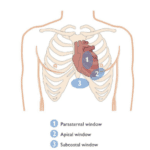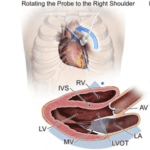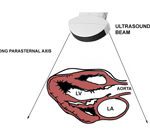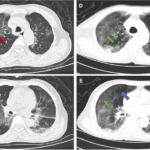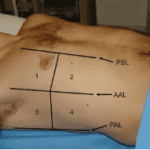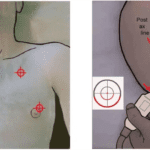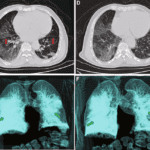By Naga Sai Akhil Reddy
Point-of-care ultrasound (POCUS) has emerged as one of the most transformative tools in modern medicine. It has revolutionized how healthcare providers assess and manage patients. Its evolution highlights not only advancements in technology but also a shift in the way healthcare is delivered. In this blog, we will explore the history of POCUS, its current applications, and what the future holds for this disruptive diagnostic tool. Carl Sagan, a famous scientist once said, “You have to know the past to understand the present.”
Past
The story of ultrasound in medicine began in the 1940’s, when scientists like Karl Dussik first discovered that sound waves could be used to create images of the internal structures of the body. It became more widely adopted in the 1960s but had many barriers to its adoption such as the large size and the high cost of devices, and the images produced were all low resolution (1). POCUS began to take shape in the 1990’s, particularly in emergency medicine and critical care. Unlike traditional imaging methods like CT scans and X-rays, which required patient transport and caused delays, POCUS allowed real-time imaging at the point of care, enabling faster diagnosis and treatment. However, POCUS use was mainly limited to emergency and critical care in the initial phase.
Present
POCUS is no longer a novelty diagnostic tool. It is a mainstream, indispensable part of clinical care across medicine often cited as the 5th pillar in bedside clinical examination (2, 3). Some of the most common uses of POCUS today include:
- Emergency Medicine: POCUS has become a cornerstone in trauma and emergency medicine. It is used to diagnose conditions like free fluid in the abdomen, often from internal bleeding, cardiac arrest, and deep vein thrombosis (DVT).
- Critical Care: In intensive care units (ICU), POCUS helps guide invasive procedures, monitor cardiac and respiratory function, and assess fluid status in critically ill patients.
- Obstetrics: In obstetrics, POCUS allows for rapid evaluation of pregnancies, including checking fetal gestational age, fetal cardiac activity and fetal position.
- Primary Care: With the advent of portable, user-friendly ultrasound devices (example – Butterfly, Clarius, EchoNous, Philips etc.), primary care providers are increasingly using POCUS for assessments such as diagnosing musculoskeletal injuries, guiding joint injections, and assessing commonly diagnosed conditions.
The growing use of POCUS has led to the development of training and certification programs to ensure safe, and effective use. Medical societies like the American College of Emergency Physicians (ACEP) and Society of Critical Care Medicine (SCCM) provide guidelines for its appropriate use. The list of applications continues to grow. The introduction of mobile ultrasound technology has further expanded POCUS accessibility. Devices that connect to smartphones or tablets allow clinicians to perform ultrasounds with an ultrasound probe, bringing diagnostic imaging to remote, rural, or underserved areas.
Future
The future of POCUS will be shaped by advances in imaging quality, accessibility, and usability (4). Key trends include:
- AI Integration: AI will assist in interpreting ultrasound images, improving speed and accuracy in diagnosing conditions.
- Miniaturization: Ultrasound devices will become more compact, enabling use in remote or field settings.
- Primary Care Expansion: POCUS will grow in primary care, allowing faster and accurate diagnoses and reducing unnecessary referrals.
- Standardization and Global Growth: Efforts to standardize practices and expand POCUS in developing countries will ensure consistent, life-saving care in underserved areas.
References
- Kaproth-Joslin KA, Nicola R, Dogra The History of US: From Bats and Boats to the Bedside and Beyond: RSNA Centennial Article. Radiographics. 2015; 35(3):960-70. doi:10.1148/rg.2015140300.
- Chelikam N, Vyas A, Desai R, et al. (December 08, 2023) Past and Present of Point-of-Care Ultrasound (PoCUS): A Narrative Review. Cureus 15(12): e50155. doi:10.7759/cureus.50155
- Narula J, Chandrashekhar Y, Braunwald E. Time to Add a Fifth Pillar to Bedside Physical Examination: Inspection, Palpation, Percussion, Auscultation, and Insonation. JAMA Cardiol. 2018; 3(4):346-350. doi:10.1001/jamacardio.2018.0001.
- Osterwalder J, Polyzogopoulou E, Hoffmann B. Point-of-Care Ultrasound—History, Current and Evolving Clinical Concepts in Emergency Medicine. 2023; 59(12):2179. doi:10.3390/medicina59122179
I want to take a moment to extend my deepest thanks to my mentors at Duke kidney for their constant support and guidance.





